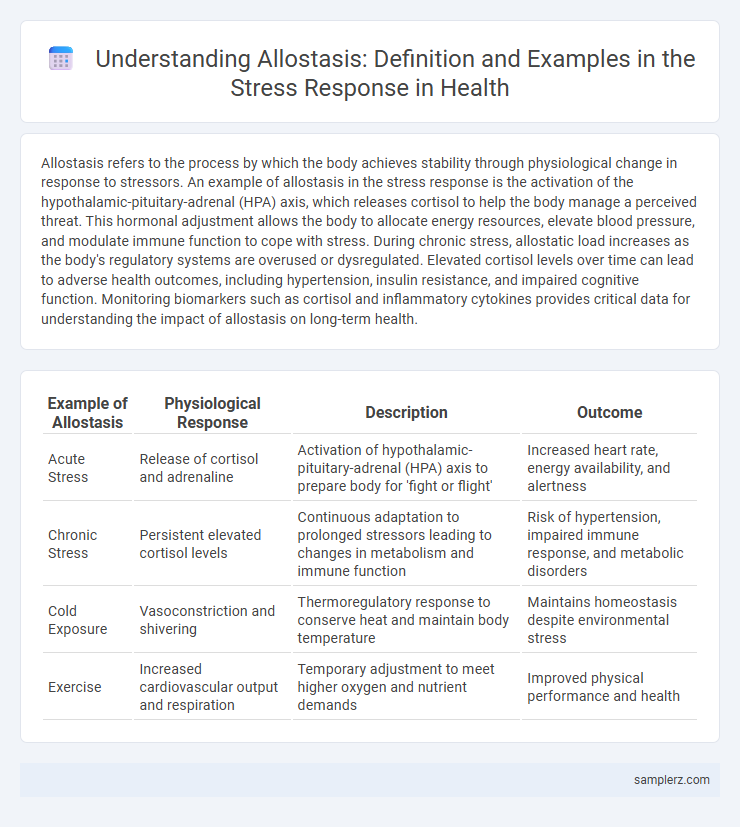Allostasis refers to the process by which the body achieves stability through physiological change in response to stressors. An example of allostasis in the stress response is the activation of the hypothalamic-pituitary-adrenal (HPA) axis, which releases cortisol to help the body manage a perceived threat. This hormonal adjustment allows the body to allocate energy resources, elevate blood pressure, and modulate immune function to cope with stress. During chronic stress, allostatic load increases as the body's regulatory systems are overused or dysregulated. Elevated cortisol levels over time can lead to adverse health outcomes, including hypertension, insulin resistance, and impaired cognitive function. Monitoring biomarkers such as cortisol and inflammatory cytokines provides critical data for understanding the impact of allostasis on long-term health.
Table of Comparison
| Example of Allostasis | Physiological Response | Description | Outcome |
|---|---|---|---|
| Acute Stress | Release of cortisol and adrenaline | Activation of hypothalamic-pituitary-adrenal (HPA) axis to prepare body for 'fight or flight' | Increased heart rate, energy availability, and alertness |
| Chronic Stress | Persistent elevated cortisol levels | Continuous adaptation to prolonged stressors leading to changes in metabolism and immune function | Risk of hypertension, impaired immune response, and metabolic disorders |
| Cold Exposure | Vasoconstriction and shivering | Thermoregulatory response to conserve heat and maintain body temperature | Maintains homeostasis despite environmental stress |
| Exercise | Increased cardiovascular output and respiration | Temporary adjustment to meet higher oxygen and nutrient demands | Improved physical performance and health |
Understanding Allostasis in the Stress Response
Allostasis in the stress response involves the body's dynamic regulation of physiological systems to maintain stability through change, such as increased cortisol release and elevated heart rate during acute stress. This adaptive mechanism allows the hypothalamic-pituitary-adrenal (HPA) axis to modulate energy distribution, immune function, and cardiovascular activity based on environmental demands. Chronic activation of allostatic systems, however, can lead to allostatic load, increasing risk for conditions like hypertension, diabetes, and mental health disorders.
Key Allostatic Processes During Stress
Key allostatic processes during stress involve the activation of the hypothalamic-pituitary-adrenal (HPA) axis and the sympathetic-adrenal-medullary (SAM) system, which release cortisol and adrenaline to maintain homeostasis. These hormonal responses regulate energy distribution, cardiovascular function, and immune activity to adapt to stressors. Chronic activation of these systems can lead to allostatic load, increasing the risk of hypertension, metabolic disorders, and immune dysfunction.
Hormonal Regulation: Cortisol and Adrenaline
During stress response, allostasis regulates hormonal balance by increasing cortisol and adrenaline secretion from the adrenal glands. Cortisol mobilizes energy by elevating glucose levels, while adrenaline enhances cardiovascular function and alertness. This dynamic hormonal adjustment maintains homeostasis under external stressors, supporting resilience and recovery.
Allostasis and the Fight-or-Flight Reaction
Allostasis regulates the body's stress response by adjusting physiological parameters to maintain stability through change, especially during the fight-or-flight reaction. This adaptive process involves the release of adrenaline and cortisol, which prepare the body for immediate physical action by increasing heart rate, blood pressure, and energy supply. Efficient allostatic responses prevent damage from chronic stress, supporting resilience and overall health in stressful situations.
Neurotransmitter Shifts Under Stressful Conditions
Neurotransmitter shifts during stress involve increased release of norepinephrine and cortisol, which activate the hypothalamic-pituitary-adrenal (HPA) axis to restore homeostasis through allostasis. Elevated dopamine and glutamate levels modulate cognitive and emotional responses, enhancing vigilance and memory consolidation under threat. These dynamic neurochemical changes optimize physiological adaptation to stress, but prolonged imbalance may contribute to anxiety disorders and depression.
Cardiovascular Adaptations via Allostatic Mechanisms
Cardiovascular adaptations via allostatic mechanisms involve dynamic adjustments such as increased heart rate, elevated blood pressure, and enhanced cardiac output to meet the body's demands during stress. These changes optimize blood flow to critical organs and muscles, supporting acute physical or psychological challenges. Chronic activation of these responses can lead to adverse health outcomes, including hypertension and increased cardiovascular disease risk.
Immune System Modulation During Stress
During stress, allostasis triggers the release of cortisol and adrenaline, which modulate the immune system by suppressing inflammatory cytokine production and altering white blood cell distribution. This immune system modulation reduces immediate inflammation but can impair the body's ability to fight infections and heal wounds when stress is chronic. Understanding these allostatic changes is crucial for managing stress-related immune dysfunction and preventing related health issues.
Energy Mobilization as an Allostatic Example
Energy mobilization during stress exemplifies allostasis by triggering hormonal responses such as adrenaline and cortisol release, which increase glucose availability and elevate heart rate to meet immediate physiological demands. This adaptive mechanism reallocates energy resources, enhancing physical and mental performance in acute stress situations. Prolonged activation, however, may lead to metabolic dysregulation and increased risk of chronic conditions like hypertension and insulin resistance.
Allostasis in Chronic Versus Acute Stress
Allostasis regulates the body's stress response by maintaining stability through physiological or behavioral change. In acute stress, allostasis activates adaptive mechanisms like increased heart rate and cortisol release to restore balance quickly. Chronic stress leads to allostatic load, where prolonged activation causes wear and tear on cardiovascular, metabolic, and immune systems, increasing risk for hypertension, diabetes, and inflammation-related diseases.
Health Implications of Allostatic Load in Stress
Allostatic load refers to the cumulative wear and tear on the body's systems due to chronic stress exposure, impacting cardiovascular, metabolic, and immune health. Elevated allostatic load has been linked to increased risks of hypertension, diabetes, and impaired cognitive function, highlighting its role in stress-related disease progression. Monitoring biomarkers such as cortisol, blood pressure, and inflammatory markers helps assess allostatic load and guides interventions to reduce long-term health consequences.

example of allostasis in stress response Infographic
 samplerz.com
samplerz.com